Confusion. If there was a consistent theme running through the presentation of Honda’s new DN-01 in Milan, then this was it. Confusion first is exactly what the DN-01 is or is meant to do-it looks more like a scooter than anything else, and it has a twist-and-go transmission, so as with any other scooter, you turn the twistgrip and ride away without having to worry about gears or clutch. But its engine is very much a motorcycle unit, the easy going if rather unexciting 680cc V-twin found in the Deauville tourer, detuned to an even softer 62 horsepower, and final drive is by shaft rather than the usual belt. Between the two is a two-wheeler first, a fully variable, automatic transmission dependent on hydraulics rather than the usual belts and variable diameter pulleys. It’s certainly clever, using a swash plate (a disc mounted centrally on the end of a drive shaft, tilted like a wobbling plate) to drive hydraulic pumps which in turn drive hydraulic motors that power the rear wheel. The swash plate’s angle is varied by an ECU-controlled solenoid, effectively altering the gearing automatically.
This unique transmission and the V-twin motor are among other reasons the DN-01 is not really a scooter, according to Honda. But the bottom line is, you sit on it, you open the throttle and off it goes, and it won’t matter to the majority of owners (assuming there’s more than one…) whether it’s belts, hydraulics or witchcraft beneath the very strange looking bodywork.
It’s easy enough to ride, a design aim I do understand and commend. The transmission takes up power smoothly and the engine pulls quite strongly, with better acceleration than a Rolls Royce Phantom‚Ķyes, without any sense of the absurd, we were told that the DN-01 has a superior 0-60-mph time than the half-million-dollar luxury car. That’s 5.8 seconds if you’re interested, which happens to be very slow for a middleweight motorcycle. But then it’s not a motorcycle, says Honda, although it’s not exactly a luxury car either, is it? And the Phantom will have the DN-01 for top speed, should you ever meet one on a German autobahn.
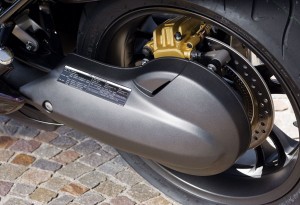
Still, the DN-01 meanwhile steers very well and the ride quality is pretty good (but I doubt it’s quite up to a Phantom’s, which is probably why the car comparison was dropped at this point), although if you’re above average height you have to duck down to see the instruments as the tiny screen’s only function appears to be hiding them.
This does relieve the back ache tall riders seem to get though, even after a short ride. Your legs are set well forward but the bars are close to the rider, so you feel as if you’re leaning slightly backward, and for me and others, it starts to hurt. You’re also perched upright in the slipstream and even 70 mph is hard work on the arms. Again, a Phantom does rather better by comparison.
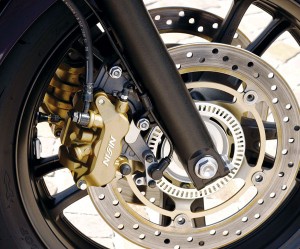
You can if you wish alter the transmission to a sportier mode, which lets the engine rev higher, or switch to “manual” where a rocker on the left bar lets you select from six virtual ratios. In practice this is merely annoying as it’s so nannying you can’t change down unless the engine is almost idling-try to select first from second for example at anything more than 10 mph and it refuses. It’s not even unique-exactly the same functions have been available on the Suzuki Burgman 650 since 2002, using an electronically controlled conventional belt drive, but on that you’re allowed to change down at any revs that won’t destroy the engine, and even then the novelty wears off after 10 minutes. Aside from a little more crispness in the Honda’s drive, you would not tell the difference either, and it’s no more efficient at power transmission than a variable belt system, but it does cost 50 percent more than a manual gearbox to produce.
Confused?
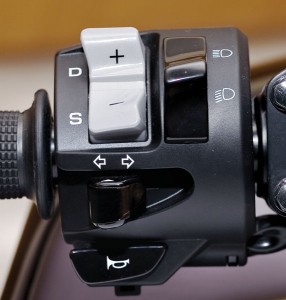
So who is it for? Honda’s marketing say the DN-01 is aimed at techno early adopters who aren’t motorcyclists, an alleged species that buys stuff because it’s technically interesting, and buys it straight away to be different. The problem here is, they’ll first need to rush out and get their bike license, which rather takes the spontaneity out of it, adding instead a heavy layer of exactly the sort of commitment I doubt these people have. If they have licenses already then they’re motorcyclists or scooterists and won’t understand the DN-01.
It’s also meant to look very cool, sufficiently so to sell to people previously uninterested in bikes. Again we have the license problem, but that’s not the only one. Maybe this is because I’m coming at it from a motorcycle and scooter angle, but I think the DN-01 looks faintly ridiculous with someone on board stuck bolt upright in the middle of its long, low form, a bit like a mobile drawing pin and certainly not cool. At best, it’s interesting.
Scooter riders won’t be the slightest bit interested as the DN-01 not only offers no wind or weather protection, it has no storage space. That’s as in, none at all, not even a tiny glove compartment, although if you buy a doughnut of the right size it will slot over the fuel filler neck. It might taste of gas afterward, though.
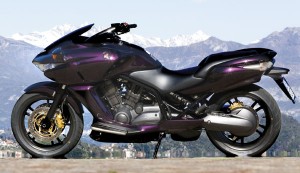
But having told us about these super-trendy early adopters with handy bike licenses but no interest in bikes, the marketing people then explained that the DN-01 is so different, essentially they’re releasing it to see who does buy it. And that’s why it has no storage space or optional luggage, because these would impose categories and preconceptions on it that will not allow it a full and free reign to find its own way. I think I got that right. And I think that sounds like more confusion: Rather than opening up possibilities, it closes them down. The DN-01 might have been a trendy choice for recently bonused city executives, except they can’t even fit a fat wallet in it, or it could have been a cool(ish) weekend away tourer. As it is, Honda will never know.
As well as the lack of weather protection and storage, one other factor distinguishes the DN-01 from other scooters (let’s face it, this is a maxi-scooter devoid of the advantages or the point of other maxi-scooters), and that’s the price. OK, it’s cheaper than a Rolls Royce, but at the price Honda is suggesting, it’s as much as a Fireblade (CBR1000RR in the United States). To put this all in perspective, even that has more storage space and better weather protection than a DN-01, and as far as I’m concerned, it’s much, much more cool. The CBR is also an awful lot faster than a Phantom, acceleration or top speed….
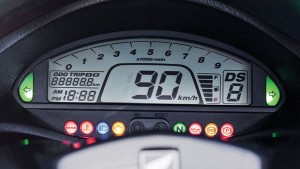
The 2009 Honda DN-01 will be sold in the United States for $14,599.
Interested in the DN-01? Want More? Check out a second 2009 Honda DN-01 Road Test by Rider‘s Mark Tuttle.







